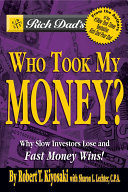

One of the cornerstone concepts in Robert Kiyosaki's teachings is the distinction between assets and liabilities. Kiyosaki emphasizes that true wealth is built through acquiring assets—things that put money in your pocket—rather than liabilities, which take money out of your pocket. In this book, he provides a clear definition of what constitutes an asset and a liability. An asset could be real estate, stocks, or a business that generates income, while a liability could include a mortgage, car loans, or credit card debt. Kiyosaki argues that many people mistakenly consider their home as an asset, while in reality, it often functions as a liability because of the ongoing expenses associated with it. Understanding this difference is crucial for anyone looking to build wealth, as it shifts the mindset from consumerism to investment. Kiyosaki encourages readers to focus on acquiring income-generating assets to achieve financial independence.
Continue readingKiyosaki stresses that financial education is vital for achieving financial freedom. He argues that traditional education systems do not adequately prepare individuals for managing money, investing, or understanding economic principles. In 'Who Took My Money?', Kiyosaki advocates for self-education in finance, investing, and economics. He encourages readers to seek out resources such as books, seminars, and mentors to improve their financial literacy. Kiyosaki believes that the more knowledgeable you are about financial matters, the better decisions you can make regarding investments and wealth-building strategies. Financial education empowers individuals to navigate the complexities of the financial world and helps them avoid common pitfalls that can lead to financial failure.
Continue readingKiyosaki emphasizes the significance of mindset in achieving financial success. He believes that a person’s beliefs about money can either propel them toward wealth or hold them back. In the book, he discusses the concept of a 'rich mindset' versus a 'poor mindset.' A rich mindset involves seeing opportunities, taking calculated risks, and being open to learning from failures. Conversely, a poor mindset is characterized by fear, complacency, and a focus on security rather than growth. Kiyosaki encourages readers to cultivate a rich mindset by embracing challenges, being proactive in their financial education, and surrounding themselves with like-minded individuals who inspire growth. This shift in mindset is essential for those looking to break free from the cycle of financial struggle.
Continue readingReal estate is one of the primary investment vehicles that Kiyosaki advocates for in 'Who Took My Money?'. He discusses the advantages of investing in real estate, such as cash flow, tax benefits, and appreciation over time. Kiyosaki provides insights into how to analyze real estate deals, the importance of location, and the need to understand market cycles. He also highlights the significance of leveraging other people's money (OPM) to finance investments, which can amplify returns. Kiyosaki shares his own experiences in real estate investing, including both successes and failures, to illustrate the potential for wealth creation through this asset class. He encourages readers to consider real estate as a viable option for building a robust investment portfolio.
Continue readingKiyosaki promotes entrepreneurship as a key pathway to financial freedom. He believes that starting a business allows individuals to create their own income streams and build wealth on their terms. In the book, he discusses the various types of businesses one can start, the importance of finding a niche, and the need to develop a strong business plan. Kiyosaki emphasizes that entrepreneurship requires a willingness to take risks and learn from mistakes. He also highlights the benefits of being an entrepreneur, such as the ability to control one’s financial destiny and the potential for unlimited income. Kiyosaki encourages readers to think creatively and consider how they can leverage their skills and passions to create successful business ventures.
Continue readingKiyosaki discusses the importance of understanding market cycles in 'Who Took My Money?'. He explains that markets go through phases of expansion and contraction, and being able to identify these cycles can help investors make informed decisions. Kiyosaki teaches readers how to analyze economic indicators, such as interest rates and employment figures, to anticipate market trends. He stresses that successful investors are those who can adapt their strategies based on the current market conditions. Kiyosaki warns against emotional investing and encourages a disciplined approach to investing that is rooted in research and analysis. By understanding market cycles, investors can position themselves to take advantage of opportunities and minimize losses.
Continue readingKiyosaki highlights the importance of surrounding oneself with a strong financial team. He believes that no one can achieve financial success alone and that having the right advisors—such as accountants, financial planners, and real estate agents—can make a significant difference. In the book, Kiyosaki discusses how to build a network of professionals who can provide guidance, support, and expertise in various areas of finance and investing. He emphasizes the need for collaboration and leveraging the knowledge of others to make better financial decisions. Kiyosaki encourages readers to seek out individuals who share their financial goals and can contribute to their journey toward wealth creation.
Continue reading